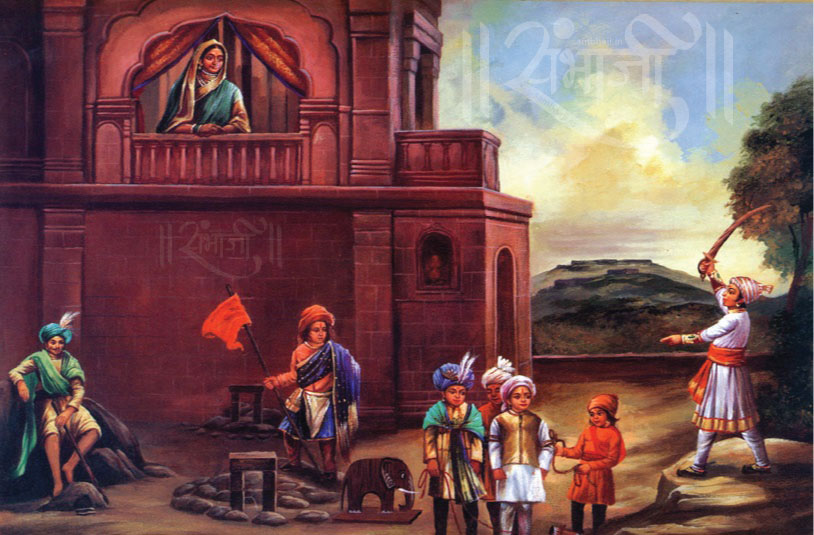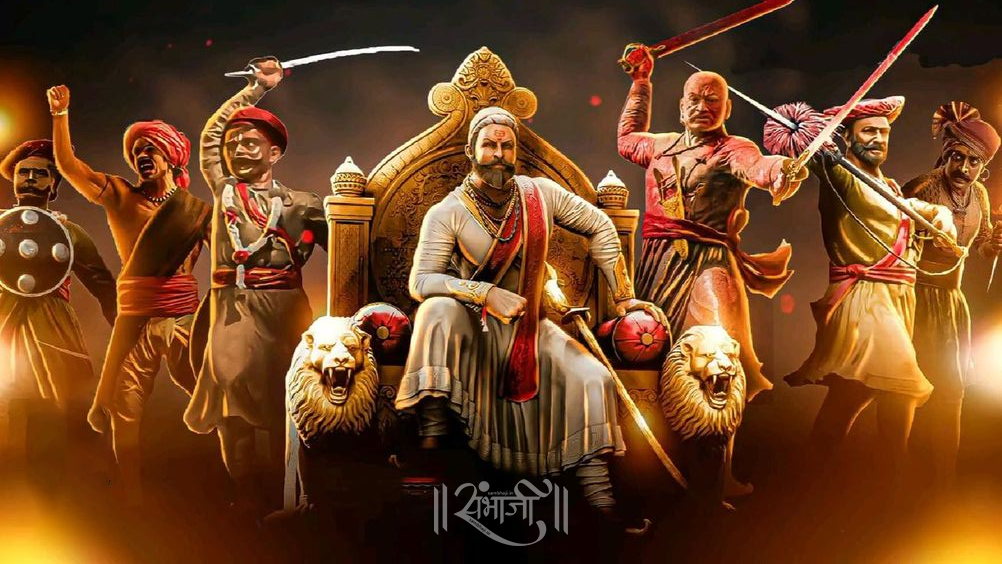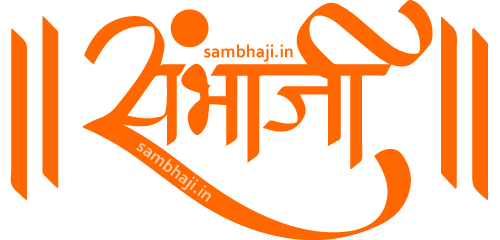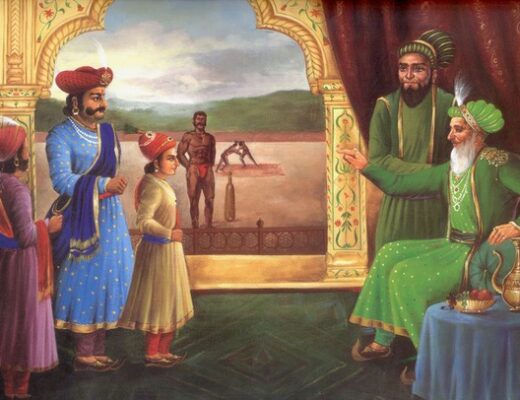Swarajya:- Chhatrapati Shivaji Maharaj was the founder of the Maratha Empire in Western India. He is considered to be one of the greatest warriors of his time and even today. His father Shahaji Bhosale was a great Maratha general in the army of Bijapur Sultanate and his mother Jijabai was a great devotee of religion. Shivaji’s mother Jijabai was the daughter of Sindkhed leader Lakhujirao Jadhav and a deeply religious woman. He was the founder of the great Maratha kingdom in India.
Shivaji was especially close to his mother who instilled in him a strict sense of right and wrong.
Childhood and Early Life
He was born on 19 February 1630 at Shivneri near the city of Junnar in the Pune district. He grew up studying Ramayana and also Mahabharata. Shivaji’s education rested on the shoulders of a small council of ministers which included a Peshwa (Shamrao Nilkanth), a Mazumdar (Balkrishna Pant), a Sabnis (Raghunath Ballal), a Dabir (Sonopant), and a chief teacher (Dadoji Konddeo). Kanhoji Jedhe and Baji Pasalkar were appointed to train Shivaji in military and martial arts. Dadoji taught him horse riding, archery, patta, and also several other fighting techniques after his father left for Karnataka with his second wife Tukabai
In 1640 he married Saibai Nimbalkar.

Struggles with the Bijapur
Shivaji Maharaj began to seize the weaker Bijapur outposts and his followers. By 1645, Shivaji acquired control of several strategic from under the Bijapur Sultanate around Pune – Torna from Inayat Khan, Chakan from Firangoji Narsala, Kondana from Adil Shahi Governor, along with Singhagarh and Purandar. After his success, he became a threat to Mohammad Adil Shah who ordered Shahaji’s imprisonment in 1648. Shahaji was released on the condition that Shivaji keep a low profile and avoid further conquests. After Shahaji’s death, Shivaji regained the Jawali valley from the Bijapuri Jagirdar Chandra Rao More. Mohammad Adil Shah sent Afzal Khan, a powerful general, to subdue Shivaji.
The two met in a private meeting on 10 November 1659 to discuss the terms of the negotiations. Shivaji guessed it was a trap and prepared by wearing armor and hiding a metal tiger claw. When Afzal Khan attacked Shivaji with a dagger, he was saved by his armor and Shivaji retaliated by attacking Afzal Khan with a tiger claw, mortally wounding him. He ordered his army to attack the leaderless Bijapuri contingent.
Shivaji’s victory was easy at the Battle of Pratapgarh, where around 3000 Bijapuri soldiers were killed by the Maratha army. Mohammad Adil Shah next sent a large army under General Rustam Zaman who faced Shivaji in the Battle of Kolhapur. Shivaji won a strategic battle that sent the general fleeing for his life. Mohammad Adil Shah was finally victorious on 22 September 1660 when his general Siddi Jauhar successfully besieged the fort of Panhala. Shivaji recaptured the Panhala Fort in 1673.
Struggles with the Mughals
Chhatrapati Shivaji’s struggled with the Bijapur Sultanate and his continued victories brought him under the radar of Mughal Emperor Aurangzeb. Aurangzeb saw him as a threat to the expansion of his imperial ambitions and concentrated his efforts on eliminating the Maratha threat. The conflict began in 1957 when Shivaji’s generals raided and plundered Mughal territories near Ahmednagar and Junnar. However, Aurangzeb’s revenge was thwarted by the arrival of the monsoon and a series of battles in Delhi. Aurangzeb directed Shaista Khan, the governor of the Deccan, and his maternal uncle to subdue Shivaji. Shaista Khan attacked Shivaji vigorously, capturing many of his forts and his capital Poona.
Shivaji retaliated by stealthily attacking Shaistakhana, eventually wounding him and driving him out of Poona. Shaistakhana later launched several attacks on Shivaji and reduced his possession of Konkan forts. To replenish his depleted treasury, Shivaji attacked Surat, a Mughal trade center, and looted Mughal wealth. Angered, Aurangzeb sent his commander-in-chief Jai Singh I with an army of one and a half lakh. The Mughal army besieged the forts held by Shivaji, extorted money, and massacred the soldiers. Shivaji agreed to a treaty with Aurangzeb to avoid further loss of life, and on 11 June 1665, the Treaty of Purandar was signed between Shivaji and Jai Singh. Shivaji agreed to surrender 23 forts and pay an indemnity of 400000 to the Mughals. Empire.
Aurangzeb invited Shivaji to Agra with the intention of using his military prowess to strengthen the Mughal Empire in Afghanistan. Shivaji went to Agra with his eight-year-old son Sambhaji and was displeased with Aurangzeb’s treatment of him. He left the court and was put under house arrest by the displeased Aurangzeb. But Shivaji once again used his wits and cunning to escape from captivity. He anticipated a serious illness and arranged for baskets of sweets to be sent to the temple as offerings for prayers.
He disguised himself as one of the carriers and hid his son in a basket and escaped from there on 17 August 1666. In the period that followed, Mughal and Maratha hostilities were largely pacified through continued mediation by the Mughal chieftain Jaswant Singh. Peace prevailed till 1670, after which Shivaji attacked the Mughals everywhere. He regained most of the territory besieged by the Mughals in four months.
Relations with the British
In the early days of his reign, Shivaji maintained cordial relations with the British, until he supported the Bijapur Sultanate in 1660 in a battle to capture the Panhala fort. So in 1670, Shivaji protested against the British in Bombay not to sell to the British war material. The conflict continued in 1971 when the British refused to support his Danda-Rajpuri raid and looted British factories in Rajapur. Many negotiations between the two parties failed and the British did not support their efforts.
Rise of Chhatrapati Shivaji Maharaj
By the 16th century, the Deccan region of India came under the Delhi-based Mughal Empire. The northern Adilshahi Sultanate, a tributary state of the Mughal emperor, occupied the highlands of the Marathas. Shahaji Bhosale was established as the Chieftain of the Bhosale clan. Later, he became a rebel and launched campaigns and raids against the Mughal Empire, which established forts. However, they were supported by the Bijapur government but were never successful. So he had to flee to the fort along with his mother-in-law and son Shivaji. The kingdom where Shivaji grew up made him a great king.
By age 16, he had a group of soldiers and continued to fight for Shahaji. In 1647 he took charge of Poona against the Bijapur government. This was a big step and it led to conflict with Bijapur. After that, within a short period of time, they also captured the forts of Purandhara, Kondhana, and Chakan. After that, the cities of Supa, Baramati, and Inderpuri came under the control of Shivaji Maharaj. The loot he collected helped him build the capital fort at Raigad. Shivaji Maharaj is more famous for the new military strategies he devised to fight enemies in such terrain. This new method of running the gorillas helped him to capture several forts in no time and a significant part of the region was under his control.


The Bijapur government became aware of their victory and imprisoned Shahaji in 1648. A year after his release, Shivaji Maharaj remained low and consolidated the territories under his rule. In 1656 he resumed raids and campaigns and captured the Javali Valley near Mahabaleshwar. Besides, Shivaji Maharaj successfully subjugated many other dynasties under Adil Shah of Bijapur with Deshmukhi power.
How Did Chratrapati Shivaji Maharaj Die?
The exact cause of Shivaji Maharaj’s death is not yet known. It is reported that Shivaji Maharaj passed away on the eve of Hanuman Jayanti. Many scholars and historians say that he died after falling seriously ill. Mythology also claims that his second wife Soyrabai poisoned his 10-year-old son Rajaram to make him the heir to the kingdom.
Finally, Shivaji’s life was filled with enmity with the surrounding kingdoms of Maratha territory and alliances to fight wars. Ultimately, he established the kingdom of the Marathas and is still remembered as one of the greatest kings of India.
Jay Shivray, Jay Jijau Jay Shambhuraje…
For More Information Follow Us On Facebook | Instagram | YouTube | Twitter | Telegram



